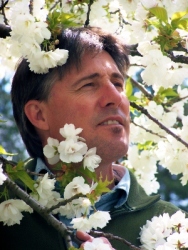 Pest and Life Cycle – (Sawadaea bicornis or Sawadaea tulasnei) Powdery Mildew is a fungal disease that overwinters on the fallen leaves and live buds of infected Norway Maple (Acer platanoides) trees. A combination of high humidity and drought stress favours this disease, with symptoms being quite visible by midsummer in coastal British Columbia – although in other parts of the country they may appear much later.
Pest and Life Cycle – (Sawadaea bicornis or Sawadaea tulasnei) Powdery Mildew is a fungal disease that overwinters on the fallen leaves and live buds of infected Norway Maple (Acer platanoides) trees. A combination of high humidity and drought stress favours this disease, with symptoms being quite visible by midsummer in coastal British Columbia – although in other parts of the country they may appear much later.
Symptoms – Leaves develop powdery white patches beginning on the upper surface and can eventually cover the entire leaf. Badly infected foliage turns yellow and may drop prematurely. The lower part of the crown is usually more adversely affected.
Management – Pick up and discard (put in garbage or burn) any fallen leaves – do not compost at home. Deep water affected trees during periods of summer drought. Fungicides or chemical controls are unnecessary as this disease is superficial and rarely causes long-term damage to established trees.
Prevention – 1. Avoid planting susceptible cultivars such as ‘Crimson King’ and ‘Schwedleri’. 2. If you live near a green belt where Bigleaf Maple (Acer macrophyllum) grows, consider not planting Norway Maple. Bigleaf Maple is also affected by powdery mildew (Sawadaea bicornis) and this disease may constantly transfer to adjacent Norway Maples. 3. Plant Norway Maples in open areas with good air circulation and sun exposure, allowing enough room for the ultimate height and spread. 4. Do a little selective pruning of the crown to improve air circulation. 5. Rake-up and discard (in garbage or by burning) infected leaves in the fall – do not put them in the home compost. 6. Keep existing trees healthy and less disease prone by deep watering during dry spells and avoiding soil disturbance in the root zone.



